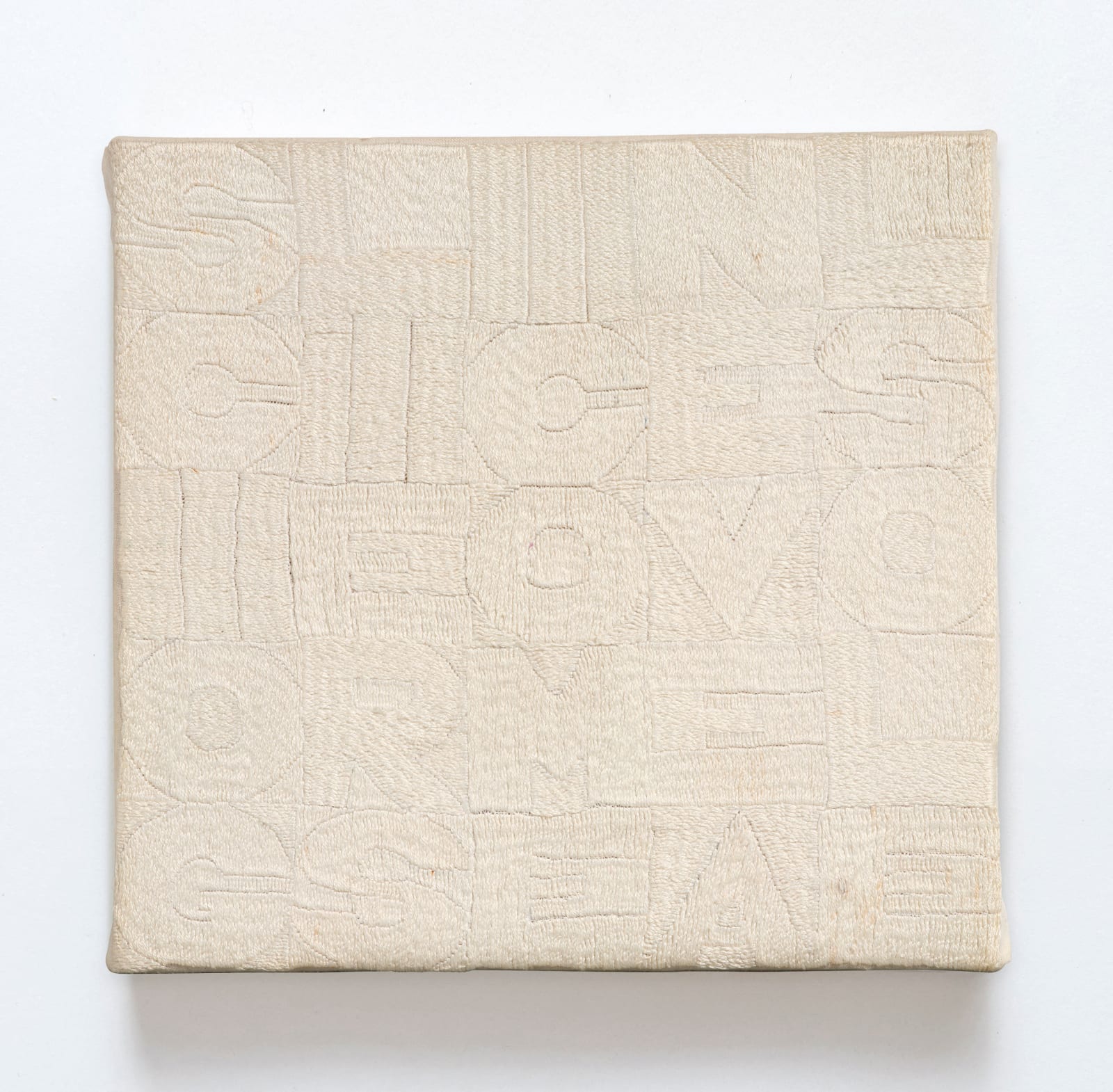
Alighiero Boetti Italian, 1940-1994
Sciogliersi Come Neve al Sole, 1989
Embroidery
21 x 22 cm. (8 1/4 x 8 5/8 in.)
Copyright The Artist
Further images
Alighiero Boetti’s Sciogliersi Come Neve al Sole (1989) is a singular example of his Arazzi series, remarkable for its stark monochrome execution. Unlike the vivid contrasts of coloured grids that...
Alighiero Boetti’s Sciogliersi Come Neve al Sole (1989) is a singular example of his Arazzi series, remarkable for its stark monochrome execution. Unlike the vivid contrasts of coloured grids that typify most of the embroideries, this work is rendered entirely in white, aligning the visual form with the phrase it contains. The title, translating as “To Melt Like Snow in the Sun”, evokes impermanence, fragility, and dissolution. In this monochrome version, the phrase itself seems to vanish into its ground, echoing the very image of snow dissolving under heat.
Boetti himself described the sentiment behind the phrase in personal terms: “How one should understand ‘Sciogliersi come neve al sole pensando a te a noi’: whom I was addressing my thoughts to back then, I no longer know. Most certainly it was a lady, a woman. After all, you melt because of heat and heat is what you receive with love, with erotic tension, with emotional being. All of this is energy. Energy = heat and heat melts the snow (the white).” The monochrome palette makes this association explicit, the whiteness of snow folded into the whiteness of the thread, so that the text seems suspended between presence and disappearance.
Dated 1989, the work belongs to the late phase of Boetti’s Arazzi, produced in Peshawar, Pakistan, by Afghan embroiderers displaced after the Soviet invasion of 1979. By this point, Boetti had honed the series into a meditation on language and paradox, often favouring short, lapidary phrases. The choice to forgo colour altogether in this embroidery pushes the logic of the Arazzi to its extreme: the order of the grid remains, but the visibility of its content recedes, so that deciphering becomes an act of attentive perception.
As with all the Arazzi, the work was the product of collaboration. Boetti provided the structure and text, while the artisans executed it with painstaking bokhara hand-stitching. Here, however, their customary freedom to play with colour was withdrawn. The uniform white insists on a different kind of subtlety: texture, shadow, and the shifting play of light across the embroidered surface become the only means through which the phrase emerges.
In Sciogliersi Come Neve al Sole, Boetti encapsulates the dualities central to his practice: order and disorder, presence and absence, legibility and obscurity. The monochrome grid does not simply present a text but enacts its meaning, melting the boundary between word and image, between the seen and the unseen.
Boetti himself described the sentiment behind the phrase in personal terms: “How one should understand ‘Sciogliersi come neve al sole pensando a te a noi’: whom I was addressing my thoughts to back then, I no longer know. Most certainly it was a lady, a woman. After all, you melt because of heat and heat is what you receive with love, with erotic tension, with emotional being. All of this is energy. Energy = heat and heat melts the snow (the white).” The monochrome palette makes this association explicit, the whiteness of snow folded into the whiteness of the thread, so that the text seems suspended between presence and disappearance.
Dated 1989, the work belongs to the late phase of Boetti’s Arazzi, produced in Peshawar, Pakistan, by Afghan embroiderers displaced after the Soviet invasion of 1979. By this point, Boetti had honed the series into a meditation on language and paradox, often favouring short, lapidary phrases. The choice to forgo colour altogether in this embroidery pushes the logic of the Arazzi to its extreme: the order of the grid remains, but the visibility of its content recedes, so that deciphering becomes an act of attentive perception.
As with all the Arazzi, the work was the product of collaboration. Boetti provided the structure and text, while the artisans executed it with painstaking bokhara hand-stitching. Here, however, their customary freedom to play with colour was withdrawn. The uniform white insists on a different kind of subtlety: texture, shadow, and the shifting play of light across the embroidered surface become the only means through which the phrase emerges.
In Sciogliersi Come Neve al Sole, Boetti encapsulates the dualities central to his practice: order and disorder, presence and absence, legibility and obscurity. The monochrome grid does not simply present a text but enacts its meaning, melting the boundary between word and image, between the seen and the unseen.
